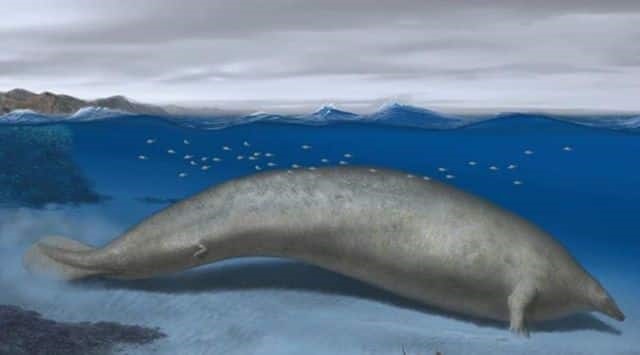Description

Disclaimer: Copyright infringement not intended.
Context
- Perucetus colossus, a prehistoric whale species that lived more than 38 million years ago, has emerged as a new contender for the title of the heaviest animal ever to have existed.
- Recent findings based on a newly-described fossil in Peru suggest that it might have outweighed even the massive blue whale, known as the largest animal on Earth
Details
- It is also known as the giant Peruvian sperm whale.
Taxonomy and Discovery
- Perucetus colossus belongs to the family Kogiidae, a group of toothed whales that includes modern-day pygmy and dwarf sperm whales.
- The first fossil evidence of Perucetus colossus was discovered in Peru, South America, hence the name "Perucetus."
Physical Characteristics
- Size: Perucetus colossus was one of the largest prehistoric whales known, reaching lengths of up to 60 feet (18 meters).
- Skull and Jaw: The species possessed a massive skull and a formidable jaw equipped with sharp teeth, suggesting it was a powerful predator.
- Limbs: Perucetus colossus exhibited vestigial hind limbs, a characteristic shared with other ancient whales, indicating a partial adaptation to land.

Paleoenvironment
- Geological Era: Perucetus colossus lived during the late Miocene epoch, approximately 10-12 million years ago.
- Habitat: It inhabited the ancient oceans surrounding the South American continent.
- Paleoecology: Fossil evidence suggests that Perucetus colossus was likely a deep-diving predator, preying on large marine creatures in its ecosystem.
Behavior and Feeding Habits
- Predatory Nature: Perucetus colossus was a formidable predator, possibly preying on a variety of marine organisms, including fish, cephalopods, and other smaller marine mammals.
- Feeding Strategies: The presence of sharp teeth in its massive jaws indicates that it may have employed a biting and gripping feeding strategy, akin to modern sperm whales.
Size and Weight
- Blue Whales: Blue whales are renowned for their immense size, measuring up to 29.9 meters in length and weighing around 180,000 kilograms. They are the largest animals living today.
- Perucetus colossus: Although it might not have been as long as a blue whale, Perucetus colossus could have exceeded its weight. Scientists estimate its weight to be between 85 and a staggering 340 tonnes.
Fossil Discovery
- Location: The fossil remains of Perucetus colossus were found in Peru, South America.
- Bones Discovered: The discovery consisted of 13 vertebrae, 4 ribs, and a portion of the pelvis of this ancient whale species.
Pachyosteosclerosis
- Unusual Bone Characteristics: The bones of Perucetus colossus displayed an unusually large volume and extreme density, which is termed pachyosteosclerosis.
- Comparison to Living Whales: This characteristic is absent in modern-day whales, dolphins, and porpoises. Instead, it is found in sirenians, a marine mammal group that includes sea cows.
Diving Abilities
- Lung Capacity: Whales that dive deep into the ocean can empty their lungs completely to facilitate deep dives.
- Probable Shallow Diver: Perucetus colossus likely inhabited shallow coastal areas and might have dived with air in its lungs.
- Heavy Bones for Staying Near Seafloor: The unusually dense bones of Perucetus colossus could have aided it in staying close to the seafloor despite having air-filled lungs.
Possible Lifestyle
- Similarity to Sirenians: Due to its giant size and lifestyle, Perucetus colossus might have resembled sirenians, marine mammals that include sea cows.
- Steller's Sea Cow: Researchers suggest that the appearance and lifestyle of Perucetus colossus might have been reminiscent of Steller's sea cow, a species discovered in 1741 and later driven to extinction by human activities.

Conclusion
Perucetus colossus, a prehistoric giant, has captivated researchers with its remarkable weight and unique bone characteristics. While the blue whale remains the longest animal on Earth, this newly-described whale fossil challenges the notion of size and weight in the ancient oceans. Further research and discoveries may shed more light on the fascinating world of ancient marine life and the diversity of the largest creatures to have ever lived on our planet.
|
PRACTICE QUESTION
Q. Which of the following statements about Perucetus colossus is true?
Options:
a) Perucetus colossus lived approximately 10-12 million years ago.
b) Perucetus colossus was longer than the blue whale.
c) Perucetus colossus had pachyosteosclerosis in its bones.
d) Perucetus colossus had vestigial hind limbs.
Answer: c
|
https://indianexpress.com/article/technology/science/perucetus-colossus-heaviest-whale-8874552/












